Quantifying and Rating the Energy Resilience Performance of Buildings Integrated with Renewables in the Nordics under Typical and Extreme Climatic Conditions
Abstract
:1. Introduction
- A close comparison of the energy resilience performance of buildings (old and new) is integrated with renewable energy sources and storage or without renewables under typical, extreme cold, and warm climatic conditions of the Nordics to analyze their active and passive habitability conditions.
- The article introduces an energy resilience technical framework, indicators, and a color rating mechanism for the building stock in Finland to grade buildings in terms of their energy resilience performance. These indicators are applied to both old and new building case studies and later color-graded.
- Total cost calculations are carried out to estimate the techno-economic aspects of different alternative solutions in typical and extreme climate conditions.
2. Materials and Methods
2.1. TRNSYS Simulation
2.2. Building Design for Simulations
2.3. Energy System Design for Simulation
2.4. Weather: Typical and Extreme Conditions
Synthesized Weather Datasets: TDY, EWY and ECY
3. Energy Resilience: Technical and Economic Calculation Methods for Parametric Analysis
3.1. Energy Resilience Framework and Indicator Calculations
- PST represents the indoor set point temperature (i.e., 21.5 °C) [49].
- PRT represents the robustness threshold. If the performance is below this point, then the building is not robust. The recommended value is 18 °C for health reasons [63].
- Robustness period (RP) give the length of time that the building remains robust after the power is cut.
- PHT gives the habitability threshold for the occupants. Below this point, a building is unable to provide a minimum living environment for its occupants. Here, 15 °C is utilized as the threshold for habitability.
- Pmin represents the minimum indoor temperature the building reaches during the power outage.
- Recovery speed (RS) gives the speed at which the building reaches the target indoor set point (21.5 °C) after the availability of power supply is restored.
- Robustness threshold duration (RT) = This represents the duration that the building’s indoor temperature can be maintained above the robustness threshold (PRT). A higher value means the building is better prepared to face the disruptive event (power outage).
- Collapse speed (CS) = This represents the swiftness at which the building’s indoor temperature and performance drop from the set point to the habitability threshold PHT. Lower value is better.
- Impact of failure (IoF) = This represents the power outage impact on the building’s performance. It presents the minimum performance of the building reached during the power outage. A smaller value means the building can absorb the disruptive event better and adapt.
- Recovery speed (RS) = This represents the speed at which the building’s indoor temperature reaches the target point after the availability of the power supply is restored.
3.2. Parametric Study
3.3. Cost Calculations
4. Results and Discussion
4.1. Old and New Building Heating Demands in TDY, EWY and ECY Climate Scenarios
4.2. Energy Resilience in Old Building (Case 1)
4.2.1. Case 1a, Old Building: TDY
Case 1a: Winter Season (TDY)
Case 1a: Spring Season (TDY)
4.2.2. Case 1b, Old Building: EWY
Case 1b: Winter Season (EWY)
Case 1b: Spring Season (EWY)
4.2.3. Case 1c, Old Building: ECY
Case 1c: Winter Season (ECY)
Case 1c: Spring Season (ECY)
4.3. Energy Resilience in New Building (Case 2)
4.3.1. Case 2a, New Building: TDY
Case 2a: Winter Season (TDY)
Case 2a: Spring Season (TDY)
4.3.2. Case 2b, New Building: EWY
Case 2b: Winter Season (EWY)
Case 2b: Spring Season (EWY)
4.3.3. Case 2c, New Building: ECY
Case 2c: Winter Season (ECY)
Case 2c: Spring Season (ECY)
- It has been found that during winters, both buildings perform worse compared to the spring season for all climatic scenarios (TDY, EWY, and ECY). Both the buildings in winter have a shorter duration of robustness and habitability thresholds compared to the spring season. Therefore, efforts are needed to improve the performance of the buildings during winter.
- The color rating system introduced in the study is based on the proposed energy resilience framework and key performance indicators. It is observed that usually the collapse speed is slower, and the recovery speed is faster in the spring season compared to the same building in winter. However, these two indicators depend on the impact of failure.
- Typically, during EWY, it has been found that the same building has a longer duration for the robustness and habitability threshold. On the contrary, during ECY, it has been found that the same building performs worse, as it has a shorter duration for the robustness and habitability thresholds. This can also be observed when using the proposed color grading system and DoD to rate the performance of the building.
- The new building performed better in terms of the robustness threshold, habitability threshold, and impact of failure. Moreover, the collapse speed and recovery speed are better for the new building.
- Table 7 compares the combined DoD performances of the new and old buildings for the TDY climatic scenario, during winters. Most of the DoD for the new building has yellow and green colors, indicating good performance. On the other hand, the old building has orange and red colors, indicating worse performance. It also shows that color grading can support decision-making related to selecting optimal points and comparing the performances of the buildings. This grading system can also support providing guidelines to improve resilience, such as by renovating the old building so the color grade can change towards green or yellow, for long-term resilience.
- Table 7 shows that with the addition of photovoltaic (PV) technology, the performance improved for both the old and new buildings. However, when solar energy is not available, the PV does not provide much support, for instance in winter. In this case, batteries are used to provide a certain level of resilience.
5. Conclusions
- In general, it is observed that in Finnish climatic conditions, a new building can provide better thermal resilience and comfort for longer durations. The duration of failing the habitability threshold is smaller for the new building compared to an old building.
- For an old building without PV, it is observed that when a power outage occurs and the heating stops, the indoor set point temperature decreases. The robustness duration decreases as the climatic scenario varies from extreme EWY to ECY. When comparing the DoD, it can be observed that the DoD increases from EWY to ECY. A higher DoD indicates worse performance. Moreover, during the spring season, the building is more resilient compared to the winter season.
- For an old building with PV and battery, the robustness and habitability duration increases. When comparing the DoD, it can be observed that the DoD decreases when the PV and battery are integrated. This indicates that with the integration of renewable energy and battery storage, disruption and habitability thresholds can be met during extreme winter conditions.
- New and old buildings perform differently when compared to each other. The robustness and habitability duration of the new building is better.
- With a small PV area and battery capacity, the new building reaches an optimal point compared to the old building, which requires a larger PV area and battery capacity to achieve a good performance level. With the addition of PV and battery, the DoD of the new building becomes 0.
- It is observed that the economic aspect varied depending on the building type and climate scenarios. The optimal energy resilience performance can be reached with a small PV area and battery capacity for the new building. In, addition, the optimal energy resilience performance is achieved with higher total costs in the ECY climate scenario for the same building type. Therefore, techno-economic optimal points varied based on the building type and climate scenarios.
Author Contributions
Funding
Data Availability Statement
Acknowledgments
Conflicts of Interest
Appendix A
| PV Area, m2 | 0 | 50 | 75 | 100 | ||||||||||||
|---|---|---|---|---|---|---|---|---|---|---|---|---|---|---|---|---|
| Battery Capacity, kWh | 0 | 44 | 89 | 133 | 0 | 44 | 89 | 133 | 0 | 44 | 89 | 133 | 0 | 44 | 89 | 133 |
| Robustness duration (RT), hour | 2.00 | 2.00 | 2.00 | 2.00 | 2.00 | 16.00 | 24.00 | 24.00 | 2.00 | 17.00 | 31.00 | 31.00 | 2.00 | 17.00 | 31.00 | 31.00 |
| Impact of failure (IoF), °C | 7.669 | 7.669 | 7.669 | 7.669 | 7.541 | 6.615 | 6.212 | 6.212 | 7.482 | 6.557 | 5.886 | 2.446 | 7.424 | 6.506 | 5.886 | 2.443 |
| Collapse speed (CS), °C/h | 0.247 | 0.247 | 0.247 | 0.247 | 0.243 | 0.213 | 0.200 | 0.200 | 0.241 | 0.212 | 0.190 | 0.079 | 0.239 | 0.217 | 0.190 | 0.079 |
| Recovery speed (RS), °C/h | 1.917 | 1.917 | 1.917 | 1.917 | 1.885 | 1.654 | 1.553 | 1.553 | 1.871 | 1.639 | 1.471 | 0.611 | 1.856 | 1.627 | 1.471 | 0.611 |
| Degree of disruption (DoD) | 0.357 | 0.357 | 0.357 | 0.357 | 0.351 | 0.308 | 0.289 | 0.289 | 0.348 | 0.305 | 0.274 | 0.114 | 0.334 | 0.293 | 0.274 | 0.114 |
| PV cost (€) | 0 | 0 | 0 | 0 | 6838 | 6838 | 6838 | 6838 | 9851 | 9851 | 9851 | 9851 | 12,864 | 12,864 | 12,864 | 12,864 |
| Battery cost (€) | 0 | 39,377 | 79,649 | 119,027 | 0 | 39,377 | 79,649 | 119,027 | 0 | 39,377 | 79,649 | 119,027 | 0 | 39,377 | 79,649 | 119,027 |
| PV Area, m2 | 0 | 50 | 75 | 100 | ||||||||||||
|---|---|---|---|---|---|---|---|---|---|---|---|---|---|---|---|---|
| Battery Capacity, kWh | 0 | 44 | 89 | 133 | 0 | 44 | 89 | 133 | 0 | 44 | 89 | 133 | 0 | 44 | 89 | 133 |
| Robustness duration (RT), hour | 4.00 | 4.00 | 4.00 | 4.00 | 8.00 | 21.00 | 31.00 | 31.00 | 9.00 | 21.00 | 31.00 | 31.00 | 9.00 | 21.00 | 31.00 | 31.00 |
| Impact of failure (IoF), °C | 5.963 | 5.963 | 5.963 | 5.963 | 5.774 | 5.129 | 0.013 | 0.013 | 5.717 | 5.130 | 0.013 | 0.013 | 5.697 | 5.130 | 0.013 | 0.013 |
| Collapse speed (CS), °C/h | 0.284 | 0.284 | 0.284 | 0.284 | 0.275 | 0.244 | 0.001 | 0.001 | 0.272 | 0.244 | 0.001 | 0.001 | 0.247 | 0.217 | 0.190 | 0.079 |
| Recovery speed (RS), °C/h | 0.497 | 0.497 | 0.497 | 0.497 | 0.481 | 0.513 | 0.001 | 0.001 | 0.476 | 0.513 | 0.001 | 0.001 | 0.475 | 0.513 | 0.001 | 0.001 |
| Degree of disruption (DoD) | 0.188 | 0.188 | 0.188 | 0.188 | 0.182 | 0.162 | 0.000 | 0.000 | 0.180 | 0.162 | 0.000 | 0.000 | 0.180 | 0.162 | 0.000 | 0.000 |
| PV cost (€) | 0 | 0 | 0 | 0 | 6838 | 6838 | 6838 | 6838 | 9851 | 9851 | 9851 | 9851 | 12,864 | 12,864 | 12,864 | 12,864 |
| Battery cost (€) | 0 | 39,377 | 79,649 | 119,027 | 0 | 39,377 | 79,649 | 119,027 | 0 | 39,377 | 79,649 | 119,027 | 0 | 39,377 | 79,649 | 119,027 |
| PV Area, m2 | 0 | 50 | 75 | 100 | ||||||||||||
|---|---|---|---|---|---|---|---|---|---|---|---|---|---|---|---|---|
| Battery Capacity, kWh | 0 | 44 | 89 | 133 | 0 | 44 | 89 | 133 | 0 | 44 | 89 | 133 | 0 | 44 | 89 | 133 |
| Robustness duration (RT), hour | 3.00 | 3.00 | 3.00 | 3.00 | 3.00 | 17.00 | 30.00 | 31.00 | 3.00 | 17.00 | 31.00 | 31.00 | 3.00 | 17.00 | 31.00 | 31.00 |
| Impact of failure (IoF), °C | 6.424 | 6.424 | 6.424 | 6.424 | 6.370 | 5.438 | 3.704 | 1.976 | 6.345 | 5.413 | 0.012 | 0.012 | 6.320 | 5.389 | 0.012 | 0.012 |
| Collapse speed (CS), °C/h | 0.207 | 0.207 | 0.207 | 0.207 | 0.205 | 0.175 | 0.119 | 0.064 | 0.205 | 0.175 | 0.000 | 0.000 | 0.204 | 0.174 | 0.000 | 0.000 |
| Recovery speed (RS), °C/h | 3.212 | 3.212 | 3.212 | 3.212 | 3.185 | 2.719 | 1.852 | 0.988 | 2.115 | 2.707 | 0.006 | 0.006 | 2.107 | 2.694 | 0.006 | 0.006 |
| Degree of disruption (DoD) | 0.299 | 0.299 | 0.299 | 0.299 | 0.296 | 0.253 | 0.172 | 0.092 | 0.295 | 0.252 | 0.001 | 0.001 | 0.294 | 0.251 | 0.001 | 0.001 |
| PV cost (€) | 0 | 0 | 0 | 0 | 6838 | 6838 | 6838 | 6838 | 9851 | 9851 | 9851 | 9851 | 12,864 | 12,864 | 12,864 | 12,864 |
| Battery cost (€) | 0 | 39,377 | 79,649 | 119,027 | 0 | 39,377 | 79,649 | 119,027 | 0 | 39,377 | 79,649 | 119,027 | 0 | 39,377 | 79,649 | 119,027 |
| PV Area, m2 | 0 | 50 | 75 | 100 | ||||||||||||
|---|---|---|---|---|---|---|---|---|---|---|---|---|---|---|---|---|
| Battery Capacity, kWh | 0 | 44 | 89 | 133 | 0 | 44 | 89 | 133 | 0 | 44 | 89 | 133 | 0 | 44 | 89 | 133 |
| Robustness duration (RT), hour | 5.00 | 5.00 | 5.00 | 5.00 | 9.00 | 23.00 | 31.00 | 31.00 | 10.00 | 23.00 | 31.00 | 31.00 | 10.00 | 23.00 | 31.00 | 31.00 |
| Impact of failure (IoF), °C | 5.749 | 5.749 | 5.749 | 5.749 | 5.508 | 4.635 | 0.007 | 0.007 | 5.473 | 4.609 | 0.007 | 0.007 | 5.445 | 4.583 | 0.007 | 0.007 |
| Collapse speed (CS), °C/h | 0.185 | 0.185 | 0.185 | 0.185 | 0.178 | 0.150 | 0.000 | 0.000 | 0.177 | 0.149 | 0.000 | 0.000 | 0.176 | 0.148 | 0.000 | 0.000 |
| Recovery speed (RS), °C/h | 2.875 | 2.875 | 2.875 | 2.875 | 2.754 | 2.317 | 0.004 | 0.004 | 2.737 | 2.304 | 0.002 | 0.002 | 2.722 | 2.292 | 0.002 | 0.002 |
| Degree of disruption (DoD) | 0.180 | 0.180 | 0.180 | 0.180 | 0.174 | 0.153 | 0.000 | 0.000 | 0.172 | 0.152 | 0.000 | 0.000 | 0.172 | 0.151 | 0.000 | 0.000 |
| PV cost (€) | 0 | 0 | 0 | 0 | 6838 | 6838 | 6838 | 6838 | 9851 | 9851 | 9851 | 9851 | 12,864 | 12,864 | 12,864 | 12,864 |
| Battery cost (€) | 0 | 39,377 | 79,649 | 119,027 | 0 | 39,377 | 79,649 | 119,027 | 0 | 39,377 | 79,649 | 119,027 | 0 | 39,377 | 79,649 | 119,027 |
| PV Area, m2 | 0 | 50 | 75 | 100 | ||||||||||||
|---|---|---|---|---|---|---|---|---|---|---|---|---|---|---|---|---|
| Battery Capacity, kWh | 0 | 44 | 89 | 133 | 0 | 44 | 89 | 133 | 0 | 44 | 89 | 133 | 0 | 44 | 89 | 133 |
| Robustness duration (RT), hour | 1.00 | 1.00 | 1.00 | 1.00 | 1.00 | 8.00 | 17.00 | 17.00 | 1.00 | 9.00 | 17.00 | 24.00 | 1.00 | 10.00 | 18.00 | 26.00 |
| Impact of failure (IoF), °C | 11.723 | 11.723 | 11.723 | 11.723 | 11.618 | 10.706 | 9.624 | 9.624 | 11.570 | 10.650 | 9.576 | 8.739 | 11.523 | 10.608 | 9.528 | 8.553 |
| Collapse speed (CS), °C/h | 0.378 | 0.378 | 0.378 | 0.378 | 0.375 | 0.345 | 0.310 | 0.310 | 0.373 | 0.344 | 0.309 | 0.282 | 0.372 | 0.342 | 0.307 | 0.276 |
| Recovery speed (RS), °C/h | 0.977 | 0.977 | 0.977 | 0.977 | 1.056 | 5.353 | 4.812 | 4.812 | 1.157 | 5.325 | 4.788 | 4.370 | 1.152 | 5.304 | 4.764 | 4.277 |
| Degree of disruption (DoD) | 0.545 | 0.545 | 0.545 | 0.545 | 0.540 | 0.498 | 0.448 | 0.448 | 0.538 | 0.495 | 0.445 | 0.406 | 0.536 | 0.493 | 0.443 | 0.398 |
| PV cost (€) | 0 | 0 | 0 | 0 | 6838 | 6838 | 6838 | 6838 | 9851 | 9851 | 9851 | 9851 | 12,864 | 12,864 | 12,864 | 12,864 |
| Battery cost (€) | 0 | 39,377 | 79,649 | 119,027 | 0 | 39,377 | 79,649 | 119,027 | 0 | 39,377 | 79,649 | 119,027 | 0 | 39,377 | 79,649 | 119,027 |
| PV Area, m2 | 0 | 50 | 75 | 100 | ||||||||||||
|---|---|---|---|---|---|---|---|---|---|---|---|---|---|---|---|---|
| Battery Capacity, kWh | 0 | 44 | 89 | 133 | 0 | 44 | 89 | 133 | 0 | 44 | 89 | 133 | 0 | 44 | 89 | 133 |
| Robustness duration (RT), hour | 1.00 | 1.00 | 1.00 | 1.00 | 6.00 | 16.00 | 30.00 | 31.00 | 7.00 | 16.00 | 30.00 | 31.00 | 7.00 | 16.00 | 31.00 | 31.00 |
| Impact of failure (IoF), °C | 8.005 | 8.005 | 8.005 | 8.005 | 7.479 | 6.733 | 5.301 | 3.100 | 7.424 | 6.708 | 5.128 | 3.050 | 7.408 | 6.716 | 4.854 | 3.010 |
| Collapse speed (CS), °C/h | 0.381 | 0.381 | 0.381 | 0.381 | 0.356 | 0.321 | 0.252 | 0.098 | 0.354 | 0.319 | 0.244 | 0.098 | 0.353 | 0.320 | 0.231 | 0.098 |
| Recovery speed (RS), °C/h | 0.500 | 0.500 | 0.500 | 0.500 | 0.288 | 0.259 | 0.265 | 0.190 | 0.286 | 0.258 | 0.256 | 0.190 | 0.285 | 0.258 | 0.243 | 0.190 |
| Degree of disruption (DoD) | 0.372 | 0.372 | 0.372 | 0.372 | 0.236 | 0.212 | 0.167 | 0.141 | 0.234 | 0.211 | 0.162 | 0.141 | 0.233 | 0.212 | 0.153 | 0.141 |
| PV cost (€) | 0 | 0 | 0 | 0 | 6838 | 6838 | 6838 | 6838 | 9851 | 9851 | 9851 | 9851 | 12,864 | 12,864 | 12,864 | 12,864 |
| Battery cost (€) | 0 | 39,377 | 79,649 | 119,027 | 0 | 39,377 | 79,649 | 119,027 | 0 | 39,377 | 79,649 | 119,027 | 0 | 39,377 | 79,649 | 119,027 |
| PV Area, m2 | 0 | 50 | 75 | 100 | ||||||||||||
|---|---|---|---|---|---|---|---|---|---|---|---|---|---|---|---|---|
| Battery Capacity, kWh | 0 | 44 | 89 | 133 | 0 | 44 | 89 | 133 | 0 | 44 | 89 | 133 | 0 | 44 | 89 | 133 |
| Robustness duration (RT), hour | 10.00 | 10.00 | 10.00 | 10.00 | 10.00 | 31.00 | 31.00 | 31.00 | 10.00 | 31.00 | 31.00 | 31.00 | 10.00 | 31.00 | 31.00 | 31.00 |
| Impact of failure (IoF), °C | 5.824 | 5.824 | 5.824 | 5.824 | 5.534 | 2.120 | 0.002 | 0.002 | 5.403 | 2.120 | 0.002 | 0.002 | 5.332 | 2.120 | 0.002 | 0.002 |
| Collapse speed (CS), °C/h | 0.188 | 0.188 | 0.188 | 0.188 | 0.179 | 0.068 | 0.000 | 0.000 | 0.174 | 0.068 | 0.000 | 0.000 | 0.172 | 0.068 | 0.000 | 0.000 |
| Recovery speed (RS), °C/h | 0.529 | 0.529 | 0.529 | 0.529 | 2.767 | 1.060 | 0.001 | 0.001 | 2.701 | 1.060 | 0.001 | 0.001 | 2.666 | 1.060 | 0.001 | 0.001 |
| Degree of disruption (DoD) | 0.271 | 0.271 | 0.271 | 0.271 | 0.257 | 0.099 | 0.000 | 0.000 | 0.251 | 0.099 | 0.000 | 0.000 | 0.248 | 0.099 | 0.000 | 0.000 |
| PV cost (€) | 0 | 0 | 0 | 0 | 6838 | 6838 | 6838 | 6838 | 9851 | 9851 | 9851 | 9851 | 12,864 | 12,864 | 12,864 | 12,864 |
| Battery cost (€) | 0 | 39,377 | 79,649 | 119,027 | 0 | 39,377 | 79,649 | 119,027 | 0 | 39,377 | 79,649 | 119,027 | 0 | 39,377 | 79,649 | 119,027 |
| PV Area, m2 | 0 | 50 | 75 | 100 | ||||||||||||
|---|---|---|---|---|---|---|---|---|---|---|---|---|---|---|---|---|
| Battery Capacity, kWh | 0 | 44 | 89 | 133 | 0 | 44 | 89 | 133 | 0 | 44 | 89 | 133 | 0 | 44 | 89 | 133 |
| Robustness duration (RT), hour | 15.00 | 15.00 | 15.00 | 15.00 | 16.00 | 31.00 | 31.00 | 31.00 | 16.00 | 31.00 | 31.00 | 31.00 | 16.00 | 31.00 | 31.00 | 31.00 |
| Impact of failure (IoF), °C | 4.425 | 4.425 | 4.425 | 4.425 | 4.208 | 0.001 | 0.001 | 0.001 | 4.208 | 0.001 | 0.001 | 0.001 | 4.208 | 0.001 | 0.001 | 0.001 |
| Collapse speed (CS), °C/h | 0.211 | 0.211 | 0.211 | 0.211 | 0.200 | 0.000 | 0.000 | 0.000 | 0.200 | 0.000 | 0.000 | 0.000 | 0.200 | 0.000 | 0.000 | 0.000 |
| Recovery speed (RS), °C/h | 0.369 | 0.369 | 0.369 | 0.369 | 0.351 | 0.001 | 0.001 | 0.001 | 0.351 | 0.001 | 0.001 | 0.001 | 0.351 | 0.001 | 0.001 | 0.001 |
| Degree of disruption (DoD) | 0.139 | 0.139 | 0.139 | 0.139 | 0.133 | 0.000 | 0.000 | 0.000 | 0.133 | 0.000 | 0.000 | 0.000 | 0.133 | 0.000 | 0.000 | 0.000 |
| PV cost (€) | 0 | 0 | 0 | 0 | 6838 | 6838 | 6838 | 6838 | 9851 | 9851 | 9851 | 9851 | 12,864 | 12,864 | 12,864 | 12,864 |
| Battery cost (€) | 0 | 39,377 | 79,649 | 119,027 | 0 | 39,377 | 79,649 | 119,027 | 0 | 39,377 | 79,649 | 119,027 | 0 | 39,377 | 79,649 | 119,027 |
| PV Area, m2 | 0 | 50 | 75 | 100 | ||||||||||||
|---|---|---|---|---|---|---|---|---|---|---|---|---|---|---|---|---|
| Battery Capacity, kWh | 0 | 44 | 89 | 133 | 0 | 44 | 89 | 133 | 0 | 44 | 89 | 133 | 0 | 44 | 89 | 133 |
| Robustness duration (RT), hour | 15.00 | 15.00 | 15.00 | 15.00 | 15.00 | 31.00 | 31.00 | 31.00 | 16.00 | 31.00 | 31.00 | 31.00 | 16.00 | 31.00 | 31.00 | 31.00 |
| Impact of failure (IoF), °C | 4.784 | 4.784 | 4.784 | 4.784 | 4.661 | 0.002 | 0.002 | 0.002 | 4.605 | 0.002 | 0.002 | 0.002 | 4.548 | 0.002 | 0.002 | 0.002 |
| Collapse speed (CS), °C/h | 0.154 | 0.154 | 0.154 | 0.154 | 0.150 | 0.000 | 0.000 | 0.000 | 0.149 | 0.000 | 0.000 | 0.000 | 0.147 | 0.000 | 0.000 | 0.000 |
| Recovery speed (RS), °C/h | 2.392 | 2.392 | 2.392 | 2.392 | 2.4 | 0.001 | 0.001 | 0.001 | 2.4 | 0.001 | 0.001 | 0.001 | 2.4 | 0.001 | 0.001 | 0.001 |
| Degree of disruption (DoD) | 0.223 | 0.223 | 0.223 | 0.223 | 0.217 | 0.000 | 0.000 | 0.000 | 0.214 | 0.000 | 0.000 | 0.000 | 0.212 | 0.000 | 0.000 | 0.000 |
| PV cost (€) | 0 | 0 | 0 | 0 | 6838 | 6838 | 6838 | 6838 | 9851 | 9851 | 9851 | 9851 | 12,864 | 12,864 | 12,864 | 12,864 |
| Battery cost (€) | 0 | 39,377 | 79,649 | 119,027 | 0 | 39,377 | 79,649 | 119,027 | 0 | 39,377 | 79,649 | 119,027 | 0 | 39,377 | 79,649 | 119,027 |
| PV Area, m2 | 0 | 50 | 75 | 100 | ||||||||||||
|---|---|---|---|---|---|---|---|---|---|---|---|---|---|---|---|---|
| Battery Capacity, kWh | 0 | 44 | 89 | 133 | 0 | 44 | 89 | 133 | 0 | 44 | 89 | 133 | 0 | 44 | 89 | 133 |
| Robustness duration (RT), hour | 18.00 | 18.00 | 18.00 | 18.00 | 19.00 | 31.00 | 31.00 | 31.00 | 19.00 | 31.00 | 31.00 | 31.00 | 19.00 | 31.00 | 31.00 | 31.00 |
| Impact of failure (IoF), °C | 4.324 | 4.324 | 4.324 | 4.324 | 4.009 | 0.001 | 0.001 | 0.001 | 4.009 | 0.001 | 0.001 | 0.001 | 4.009 | 0.001 | 0.001 | 0.001 |
| Collapse speed (CS), °C/h | 0.206 | 0.206 | 0.206 | 0.206 | 0.191 | 0.000 | 0.000 | 0.000 | 0.191 | 0.000 | 0.000 | 0.000 | 0.191 | 0.000 | 0.000 | 0.000 |
| Recovery speed (RS), °C/h | 0.309 | 0.309 | 0.309 | 0.309 | 0.334 | 0.000 | 0.000 | 0.000 | 0.334 | 0.000 | 0.000 | 0.000 | 0.334 | 0.000 | 0.000 | 0.000 |
| Degree of disruption (DoD) | 0.136 | 0.136 | 0.136 | 0.136 | 0.126 | 0.000 | 0.000 | 0.000 | 0.126 | 0.000 | 0.000 | 0.000 | 0.126 | 0.000 | 0.000 | 0.000 |
| PV cost (€) | 0 | 0 | 0 | 0 | 6838 | 6838 | 6838 | 6838 | 9851 | 9851 | 9851 | 9851 | 12,864 | 12,864 | 12,864 | 12,864 |
| Battery cost (€) | 0 | 39,377 | 79,649 | 119,027 | 0 | 39,377 | 79,649 | 119,027 | 0 | 39,377 | 79,649 | 119,027 | 0 | 39,377 | 79,649 | 119,027 |
| PV Area, m2 | 0 | 50 | 75 | 100 | ||||||||||||
|---|---|---|---|---|---|---|---|---|---|---|---|---|---|---|---|---|
| Battery Capacity, kWh | 0 | 44 | 89 | 133 | 0 | 44 | 89 | 133 | 0 | 44 | 89 | 133 | 0 | 44 | 89 | 133 |
| Robustness duration (RT), hour | 3.00 | 3.00 | 3.00 | 3.00 | 3.00 | 14.00 | 29.00 | 30.00 | 3.00 | 15.00 | 29.00 | 31.00 | 3.00 | 15.00 | 29.00 | 31.00 |
| Impact of failure (IoF), °C | 10.660 | 10.660 | 10.660 | 10.660 | 10.418 | 8.375 | 5.636 | 5.654 | 10.307 | 8.265 | 5.636 | 0.021 | 10.197 | 8.155 | 5.636 | 0.021 |
| Collapse speed (CS), °C/h | 0.344 | 0.344 | 0.344 | 0.344 | 0.336 | 0.270 | 0.188 | 0.188 | 0.332 | 0.267 | 0.188 | 0.001 | 0.340 | 0.263 | 0.188 | 0.001 |
| Recovery speed (RS), °C/h | 1.777 | 1.777 | 1.777 | 1.777 | 1.736 | 2.094 | 2.818 | 2.827 | 2.577 | 2.755 | 2.818 | 0.010 | 2.039 | 2.718 | 2.818 | 0.010 |
| Degree of disruption (DoD) | 0.496 | 0.496 | 0.496 | 0.496 | 0.485 | 0.390 | 0.254 | 0.254 | 0.479 | 0.384 | 0.254 | 0.001 | 0.459 | 0.379 | 0.254 | 0.001 |
| PV cost (€) | 0 | 0 | 0 | 0 | 6838 | 6838 | 6838 | 6838 | 9851 | 9851 | 9851 | 9851 | 12,864 | 12,864 | 12,864 | 12,864 |
| Battery cost (€) | 0 | 39,377 | 79,649 | 119,027 | 0 | 39,377 | 79,649 | 119,027 | 0 | 39,377 | 79,649 | 119,027 | 0 | 39,377 | 79,649 | 119,027 |
| PV Area, m2 | 0 | 50 | 75 | 100 | ||||||||||||
|---|---|---|---|---|---|---|---|---|---|---|---|---|---|---|---|---|
| Battery Capacity, kWh | 0 | 44 | 89 | 133 | 0 | 44 | 89 | 133 | 0 | 44 | 89 | 133 | 0 | 44 | 89 | 133 |
| Robustness duration (RT), hour | 8.00 | 8.00 | 8.00 | 8.00 | 8.00 | 31.00 | 31.00 | 31.00 | 8.00 | 31.00 | 31.00 | 31.00 | 9.00 | 31.00 | 31.00 | 31.00 |
| Impact of failure (IoF), °C | 6.094 | 6.094 | 6.094 | 6.094 | 5.512 | 0.001 | 0.001 | 0.001 | 5.507 | 0.001 | 0.001 | 0.001 | 5.502 | 0.001 | 0.001 | 0.001 |
| Collapse speed (CS), °C/h | 0.290 | 0.290 | 0.290 | 0.290 | 0.262 | 0.000 | 0.000 | 0.000 | 0.262 | 0.000 | 0.000 | 0.000 | 0.262 | 0.000 | 0.000 | 0.000 |
| Recovery speed (RS), °C/h | 0.508 | 0.508 | 0.508 | 0.508 | 0.551 | 0.000 | 0.000 | 0.000 | 0.551 | 0.000 | 0.000 | 0.000 | 0.611 | 0.000 | 0.000 | 0.000 |
| Degree of disruption (DoD) | 0.192 | 0.192 | 0.192 | 0.192 | 0.174 | 0.000 | 0.000 | 0.000 | 0.174 | 0.000 | 0.000 | 0.000 | 0.173 | 0.000 | 0.000 | 0.000 |
| PV cost (€) | 0 | 0 | 0 | 0 | 6838 | 6838 | 6838 | 6838 | 9851 | 9851 | 9851 | 9851 | 12,864 | 12,864 | 12,864 | 12,864 |
| Battery cost (€) | 0 | 39,377 | 79,649 | 119,027 | 0 | 39,377 | 79,649 | 119,027 | 0 | 39,377 | 79,649 | 119,027 | 0 | 39,377 | 79,649 | 119,027 |
References
- Bertram, C.; Johnson, N.; Luderer, G.; Riahi, K.; Isaac, M.; Eom, J. Carbon Lock-in through Capital Stock Inertia Associated with Weak near-Term Climate Policies. Technol. Forecast. Soc. Chang. 2015, 90, 62–72. [Google Scholar] [CrossRef]
- Schulz, N. Lessons from the London Climate Change Strategy: Focusing on Combined Heat and Power and Distributed Generation. J. Urban Technol. 2011, 17, 3–23. [Google Scholar] [CrossRef]
- Keirstead, J.; Jennings, M.; Sivakumar, A. A Review of Urban Energy System Models: Approaches, Challenges and Opportunities. Renew. Sustain. Energy Rev. 2012, 16, 3847–3866. [Google Scholar] [CrossRef]
- Roberts, S. Effects of Climate Change on the Built Environment. Energy Policy 2008, 36, 4552–4557. [Google Scholar] [CrossRef]
- Rahif, R.; Norouziasas, A.; Elnagar, E.; Doutreloup, S.; Pourkiaei, S.M.; Amaripadath, D.; Romain, A.C.; Fettweis, X.; Attia, S. Impact of Climate Change on Nearly Zero-Energy Dwelling in Temperate Climate: Time-Integrated Discomfort, HVAC Energy Performance, and GHG Emissions. Build. Environ. 2022, 223, 109397. [Google Scholar] [CrossRef]
- Yang, W.; Lin, Y.; Ruiz, G.R.; del Olmo, A.O. Climate Change Performance of NZEB Buildings. Buildings 2022, 12, 1755. [Google Scholar] [CrossRef]
- Homaei, S.; Hamdy, M. Developing a Test Framework for Assessing Building Thermal Resilience. Build. Simul. Conf. Proc. 2021, 17, 1317–1324. [Google Scholar] [CrossRef]
- Kenward, A.; Raja, U. Blackout: Extreme Weather, Climate Change and Power Outages; Climate Central, Princeton One Palmer Square, Suite 330 Princeton, NJ 08542. 2014. Available online: https://assets.climatecentral.org/pdfs/PowerOutages.pdf (accessed on 7 June 2024).
- Chen, Y.; Moufouma-Okia, W.; Masson-Delmotte, V.; Zhai, P.; Pirani, A. Recent Progress and Emerging Topics on Weather and Climate Extremes Since the Fifth Assessment Report of the Intergovernmental Panel on Climate Change. Annu. Rev. Environ. Resour. 2018, 43, 35–59. [Google Scholar] [CrossRef]
- Steinhaeuser, K.; Ganguly, A.R.; Chawla, N.V. Multivariate and Multiscale Dependence in the Global Climate System Revealed through Complex Networks. Clim. Dyn. 2012, 39, 889–895. [Google Scholar] [CrossRef]
- Ciscar, J.-C.; Dowling, P. Integrated Assessment of Climate Impacts and Ad aptation in the Energy Sector. Energy Econ. 2014, 46, 531–538. [Google Scholar] [CrossRef]
- Auffhammer, M.; Mansur, E.T. Measuring Climatic Impacts on Energy Consumption: A Review of the Empirical Literature. Energy Econ. 2014, 46, 522–530. [Google Scholar] [CrossRef]
- Robine, J.-M.; Cheung, S.L.K.; Le Roy, S.; Van Oyen, H.; Griffiths, C.; Michel, J.P.; Herrmann, F.R. Death Toll Exceeded 70,000 in Europe during the Summer of 2003. Comptes Rendus Biol. 2008, 331, 171–178. [Google Scholar] [CrossRef] [PubMed]
- Copernicus the European Heatwave of July 2023 in a Longer-Term Context. Available online: https://climate.copernicus.eu/european-heatwave-july-2023-longer-term-context (accessed on 16 October 2023).
- CBC News Temperature Tops 40 C for First Time in 2023 as B.C. Heat Wave Gets Underway. Available online: https://www.cbc.ca/news/canada/british-columbia/bc-heat-wave-august-14-2023-1.6935750 (accessed on 16 October 2023).
- Analitis, A.; Katsouyanni, K.; Biggeri, A.; Baccini, M.; Forsberg, B.; Bisanti, L.; Kirchmayer, U.; Ballester, F.; Cadum, E.; Goodman, P.G.; et al. Effects of Cold Weather on Mortality: Results From 15 European Cities Within the PHEWE Project. Am. J. Epidemiol. 2008, 168, 1397–1408. [Google Scholar] [CrossRef] [PubMed]
- Campbell, R.J. Weather-Related Power Outages and Electric System Resiliency Specialist in Energy Policy Weather-Related Power Outages and Electric System Resiliency Congressional Research Service; Congressional Research Service, Library of Congress: Washington, DC, USA, 2012. [Google Scholar]
- Añel, J.A.; Fernández-González, M.; Labandeira, X.; López-Otero, X.; de la Torre, L. Impact of Cold Waves and Heat Waves on the Energy Production Sector. Atmosphere 2017, 8, 209. [Google Scholar] [CrossRef]
- Wu, Y.; Yang, S.; Wu, J.; Hu, F. An Interacting Negative Feedback Mechanism in a Coupled Extreme Weather–Humans–Infrastructure System: A Case Study of the 2021 Winter Storm in Texas. Front. Phys. 2022, 10, 912569. [Google Scholar] [CrossRef]
- Chang, S.E.; McDaniels, T.L.; Mikawoz, J.; Peterson, K. Infrastructure Failure Interdependencies in Extreme Events: Power Outage Consequences in the 1998 Ice Storm. Nat. Hazards 2007, 41, 337–358. [Google Scholar] [CrossRef]
- Harrigan, J.; Martin, P. Terrorism and the Resilience of Cities. Econ. Policy Rev. 2002, 8, 97–116. [Google Scholar]
- Dawn News; AFP Ukraine Warns Situation “Critical” after Russia Attacks Power Grid—DAWN.COM. Available online: https://www.dawn.com/news/1715682/ukraine-warns-situation-critical-after-russia-attacks-power-grid (accessed on 19 October 2022).
- Nguyen, A.T.; Reiter, S.; Rigo, P. A Review on Simulation-Based Optimization Methods Applied to Building Performance Analysis. Appl. Energy 2014, 113, 1043–1058. [Google Scholar] [CrossRef]
- Perera, A.T.D.; Nik, V.M.; Chen, D.; Scartezzini, J.L.; Hong, T. Quantifying the Impacts of Climate Change and Extreme Climate Events on Energy Systems. Nat. Energy 2020, 5, 150–159. [Google Scholar] [CrossRef]
- Thacker, S.; Pant, R.; Hall, J.W. System-of-Systems Formulation and Disruption Analysis for Multi-Scale Critical National Infrastructures. Reliab. Eng. Syst. Saf. 2017, 167, 30–41. [Google Scholar] [CrossRef]
- Panteli, M.; Mancarella, P. Influence of Extreme Weather and Climate Change on the Resilience of Power Systems: Impacts and Possible Mitigation Strategies. Electr. Power Syst. Res. 2015, 127, 259–270. [Google Scholar] [CrossRef]
- Homaei, S.; Hamdy, M. Thermal Resilient Buildings: How to Be Quantified? A Novel Benchmarking Framework and Labelling Metric. Build. Environ. 2021, 201, 108022. [Google Scholar] [CrossRef]
- Attia, S.; Levinson, R.; Ndongo, E.; Holzer, P.; Berk Kazanci, O.; Homaei, S.; Zhang, C.; Olesen, B.W.; Qi, D.; Hamdy, M.; et al. Resilient Cooling of Buildings to Protect against Heat Waves and Power Outages: Key Concepts and Definition. Energy Build. 2021, 239, 110869. [Google Scholar] [CrossRef]
- Alfraidi, Y.; Boussabaine, A.H. Design Resilient Building Strategies in Face of Climate Change. Int. J. Archit. Environ. Eng. 2015, 9, 23–28. [Google Scholar] [CrossRef]
- Nik, V.M.; Perera, A.T.D.; Chen, D. Towards Climate Resilient Urban Energy Systems: A Review. Natl. Sci. Rev. 2021, 8, 2021. [Google Scholar] [CrossRef] [PubMed]
- Kopányi, A.; Poczobutt, K.; Pallagi, L.Á. Resilient Cooling-Case Study of a Residential Building in Ry (Denmark). Master Thesis, Aalborg University, Aalborg, Denmark, 2020. [Google Scholar]
- Enright, P. Passive Cooling Measures for Multi-Unit Residential Buildings; Morrison Hershfield, Vancouver, BC, USA. 2017. Available online: https://vancouver.ca/files/cov/passive-cooling-measures-for-murbs.pdf (accessed on 1 September 2021).
- Twitchell, J.B.; Newman, S.F.; O’neil, R.S.; McDonnell, M.T. Planning Considerations for Energy Storage in Resilience Applications: Outcomes from the NELHA Energy Storage Conference’s Policy and Regulatory Workshop. Available online: https://www.pnnl.gov/main/publications/external/technical_reports/PNNL-29738.pdf (accessed on 9 August 2021).
- Lohse, R.; Zhivov, A. IEA EBC||Annex 73||Towards Net Zero Energy Public Communities||IEA EBC||Annex 73. Available online: https://annex73.iea-ebc.org/ (accessed on 23 October 2020).
- ur Rehman, H.; Hamdy, M.; Hasan, A. Towards Extensive Definition and Planning of Energy Resilience in Buildings in Cold Climate. Buildings 2024, 14, 1453. [Google Scholar] [CrossRef]
- Liu, X.; Wu, Y. A Review of Advanced Architectural Glazing Technologies for Solar Energy Conversion and Intelligent Daylighting Control. Archit. Intell. 2022, 1, 10. [Google Scholar] [CrossRef]
- Zhang, C.; Kazanci, O.B.; Levinson, R.; Heiselberg, P.; Olesen, B.W.; Chiesa, G.; Sodagar, B.; Ai, Z.; Selkowitz, S.; Zinzi, M.; et al. Resilient Cooling Strategies—A Critical Review and Qualitative Assessment. Energy Build. 2021, 251, 111312. [Google Scholar] [CrossRef]
- Alexandri, E.; Jones, P. Temperature Decreases in an Urban Canyon Due to Green Walls and Green Roofs in Diverse Climates. Build. Environ. 2008, 43, 480–493. [Google Scholar] [CrossRef]
- Homaei, S.; Hamdy, M. Quantification of Energy Flexibility and Survivability of All-Electric Buildings with Cost-Effective Battery Size: Methodology and Indexes. Energies 2021, 14, 2787. [Google Scholar] [CrossRef]
- Wilson, A. Passive Survivability. Available online: https://www.buildinggreen.com/op-ed/passive-survivability (accessed on 22 August 2021).
- Breesch, H.; Janssens, A. Performance Evaluation of Passive Cooling in Office Buildings Based on Uncertainty and Sensitivity Analysis. Sol. Energy 2010, 84, 1453–1467. [Google Scholar] [CrossRef]
- Statistics Finland Housing and Construction. Available online: https://stat.fi/tup/suoluk/suoluk_asuminen_en.html (accessed on 21 August 2024).
- Finnish Meteorological Institute (FMI) Download Weather Observations (Open Data). Available online: https://en.ilmatieteenlaitos.fi/ (accessed on 23 August 2023).
- University of Wisconsin TRNSYS A TRaNsient SYstems Simulation Program. Available online: https://sel.me.wisc.edu/trnsys/ (accessed on 5 September 2020).
- EQUA Simulation AB IDA ICE—Simulation Software|EQUA. Available online: https://www.equa.se/en/ida-ice (accessed on 5 September 2020).
- Sibbitt, B.; McClenahan, D.; Djebbar, R.; Thornton, J.; Wong, B.; Carriere, J.; Kokko, J. The Performance of a High Solar Fraction Seasonal Storage District Heating System—Five Years of Operation. Energy Procedia 2012, 30, 856–865. [Google Scholar] [CrossRef]
- ur Rehman, H.; Hirvonen, J.; Kosonen, R.; Sirén, K. Computational Comparison of a Novel Decentralized Photovoltaic District Heating System against Three Optimized Solar District Systems. Energy Convers. Manag. 2019, 191, 39–54. [Google Scholar] [CrossRef]
- ur Rehman, H.; Hasan, A. Energy Flexibility and Resiliency Analysis of Old and New Single Family Buildings in Nordic Climate. Build. Simul. Conf. Proc. 2023, 18, 326–333. [Google Scholar] [CrossRef]
- ur Rehman, H.; Hasan, A. Energy Flexibility and towards Resilience in New and Old Residential Houses in Cold Climates: A Techno-Economic Analysis. Energies 2023, 16, 5506. [Google Scholar] [CrossRef]
- Serda, M.; Becker, F.G.; Cleary, M.; Team, R.M.; Holtermann, H.; The, D.; Agenda, N.; Science, P.; Sk, S.K.; Hinnebusch, R.; et al. Energiatehokkuutta Koskevien Vähimmäisvaatimusten Kustannusoptimaalisten Tasojen Laskenta: Suomi; Balint, G., Antala, B., Carty, C., Mabieme, J.-M.A., Amar, I.B., Kaplanova, A., Eds.; Uniwersytet Śląski. Wydział Matematyki, Fizyki i Chemii: Helsinki, Finland, 2013; Volume 7. [Google Scholar]
- Ministry of the Environment The National Building Code of Finland—Ympäristöministeriö. Available online: https://ym.fi/en/the-national-building-code-of-finland (accessed on 22 February 2021).
- Ministry of the Environment, F. C3 NATIONAL BUILDING CODE OF FINLAND, Decree of Ministry of the Environment on thermal insulation in a building. Available online: https://www.edilex.fi/data/rakentamismaaraykset/c3e_2003.pdf (accessed on 10 June 2021).
- Hamdy, M.; Hasan, A.; Siren, K. A Multi-Stage Optimization Method for Cost-Optimal and Nearly-Zero-Energy Building Solutions in Line with the EPBD-Recast 2010. Energy Build. 2013, 56, 189–203. [Google Scholar] [CrossRef]
- ur Rehman, H.; Diriken, J.; Hasan, A.; Verbeke, S.; Reda, F. Energy and Emission Implications of Electric Vehicles Integration with Nearly and Net Zero Energy Buildings. Energies 2021, 14, 6990. [Google Scholar] [CrossRef]
- European Union. The European Parliament and the Council of the European Union Directive (EU) 2018/844 of the European Parliament and of the Council of 30 May 2018 Amending Directive 2010/31/EU on the Energy Performance of Buildings and Directive 2012/27/EU on Energy Efficiency. Off. J. Eur. Union 2018, L 156, 75–91. [Google Scholar]
- ur Rehman, H.; Reda, F.; Paiho, S.; Hasan, A. Towards Positive Energy Communities at High Latitudes. Energy Convers. Manag. 2019, 196, 175–195. [Google Scholar] [CrossRef]
- Nik, V.M. Making Energy Simulation Easier for Future Climate—Synthesizing Typical and Extreme Weather Data Sets out of Regional Climate Models (RCMs). Appl. Energy 2016, 177, 204–226. [Google Scholar] [CrossRef]
- Hong, T.; Chang, W.K.; Lin, H.W. A Fresh Look at Weather Impact on Peak Electricity Demand and Energy Use of Buildings Using 30-Year Actual Weather Data. Appl. Energy 2013, 111, 333–350. [Google Scholar] [CrossRef]
- Hosseini, M.; Javanroodi, K.; Nik, V.M. High-Resolution Impact Assessment of Climate Change on Building Energy Performance Considering Extreme Weather Events and Microclimate—Investigating Variations in Indoor Thermal Comfort and Degree-Days. Sustain. Cities Soc. 2022, 78, 103634. [Google Scholar] [CrossRef]
- Nik, V.M.; Hosseini, M. CIRLEM: A Synergic Integration of Collective Intelligence and Reinforcement Learning in Energy Management for Enhanced Climate Resilience and Lightweight Computation. Appl. Energy 2023, 350, 121785. [Google Scholar] [CrossRef]
- Javanroodi, K.; Nik, V.M. Interactions between Extreme Climate and Urban Morphology: Investigating the Evolution of Extreme Wind Speeds from Mesoscale to Microscale. Urban Clim. 2020, 31, 100544. [Google Scholar] [CrossRef]
- Nik, V.M. Application of Typical and Extreme Weather Data Sets in the Hygrothermal Simulation of Building Components for Future Climate—A Case Study for a Wooden Frame Wall. Energy Build. 2017, 154, 30–45. [Google Scholar] [CrossRef]
- World Health Organization (WHO). Recommendations to Promote Healthy Housing for a Sustainable and Equitable Future. Available online: https://www.who.int/publications/i/item/9789241550376 (accessed on 16 March 2023).
- Sengupta, A.; Al Assaad, D.; Bastero, J.B.; Steeman, M.; Breesch, H. Impact of Heatwaves and System Shocks on a Nearly Zero Energy Educational Building: Is It Resilient to Overheating? Build. Environ. 2023, 234, 110152. [Google Scholar] [CrossRef]
- EV Database Energy Consumption of Full Electric Vehicles. Available online: https://ev-database.org/cheatsheet/energy-consumption-electric-car (accessed on 16 December 2020).
- Rehman, H.U.; Nik, V.M.; Ramesh, R.; Hasan, A. Investigating the Energy Resilience Performance of the Old and New Buildings Integrated with Solar Photovoltaic and Storage under Extreme Nordic Condition. In Proceedings of the eSim 2024: 13th Conference of IBPSA-Canada, IBPSA, Edmonton, AB, Canada, 6 June 2024; Volume 13. [Google Scholar]
- International Renewable Energy Agency (IRENA) Renewable Power Generation Costs in 2021. Available online: https://www.irena.org/publications/2022/Jul/Renewable-Power-Generation-Costs-in-2021 (accessed on 13 August 2022).
- Laitinen, A.; Lindholm, O.; Hasan, A.; Reda, F.; Hedman, Å. A Techno-Economic Analysis of an Optimal Self-Sufficient District. Energy Convers. Manag. 2021, 236, 114041. [Google Scholar] [CrossRef]
- Hamdy, M.; Carlucci, S.; Hoes, P.J.; Hensen, J.L.M. The Impact of Climate Change on the Overheating Risk in Dwellings—A Dutch Case Study. Build. Environ. 2017, 122, 307–323. [Google Scholar] [CrossRef]

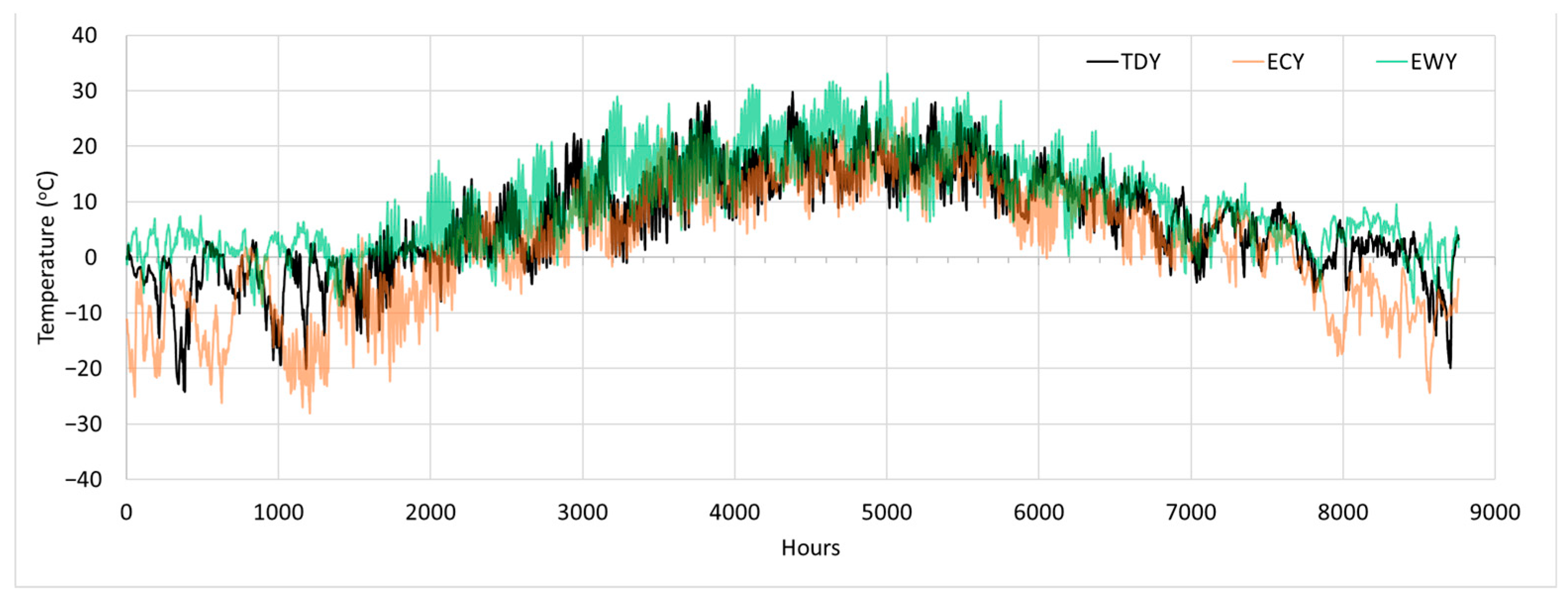


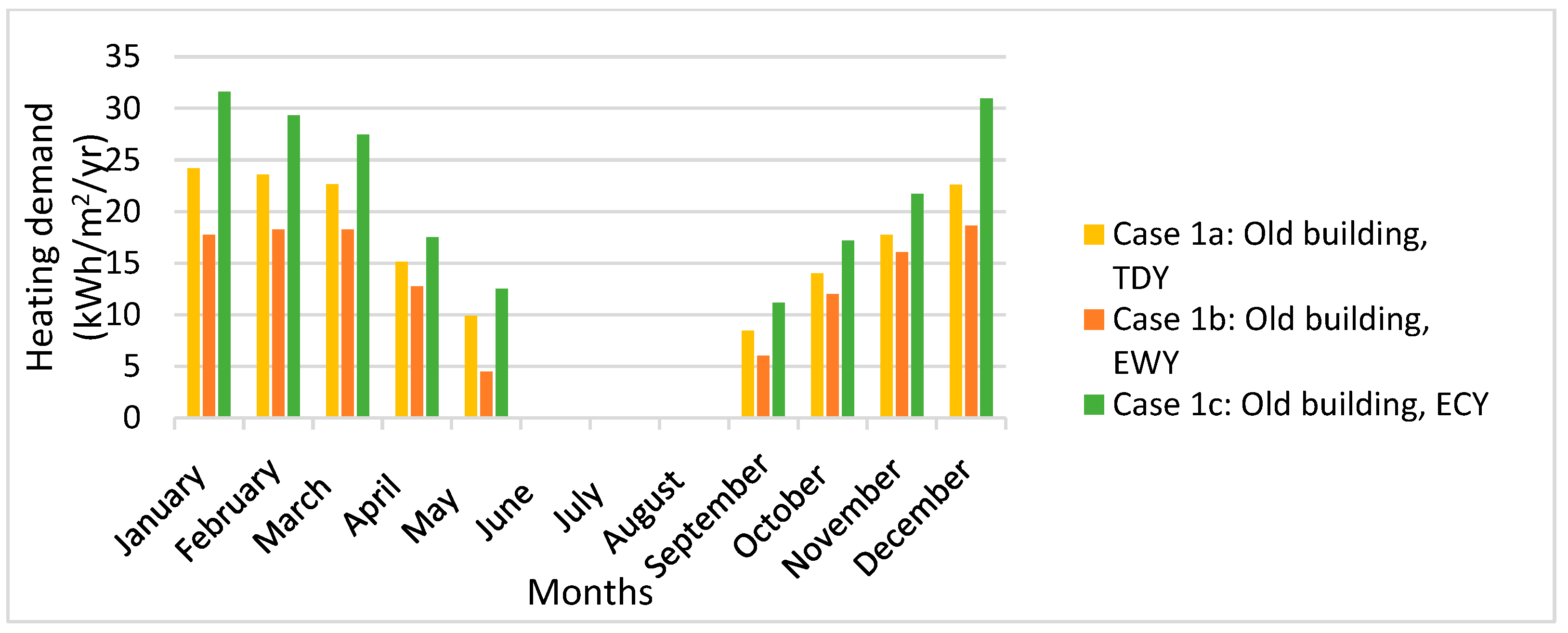
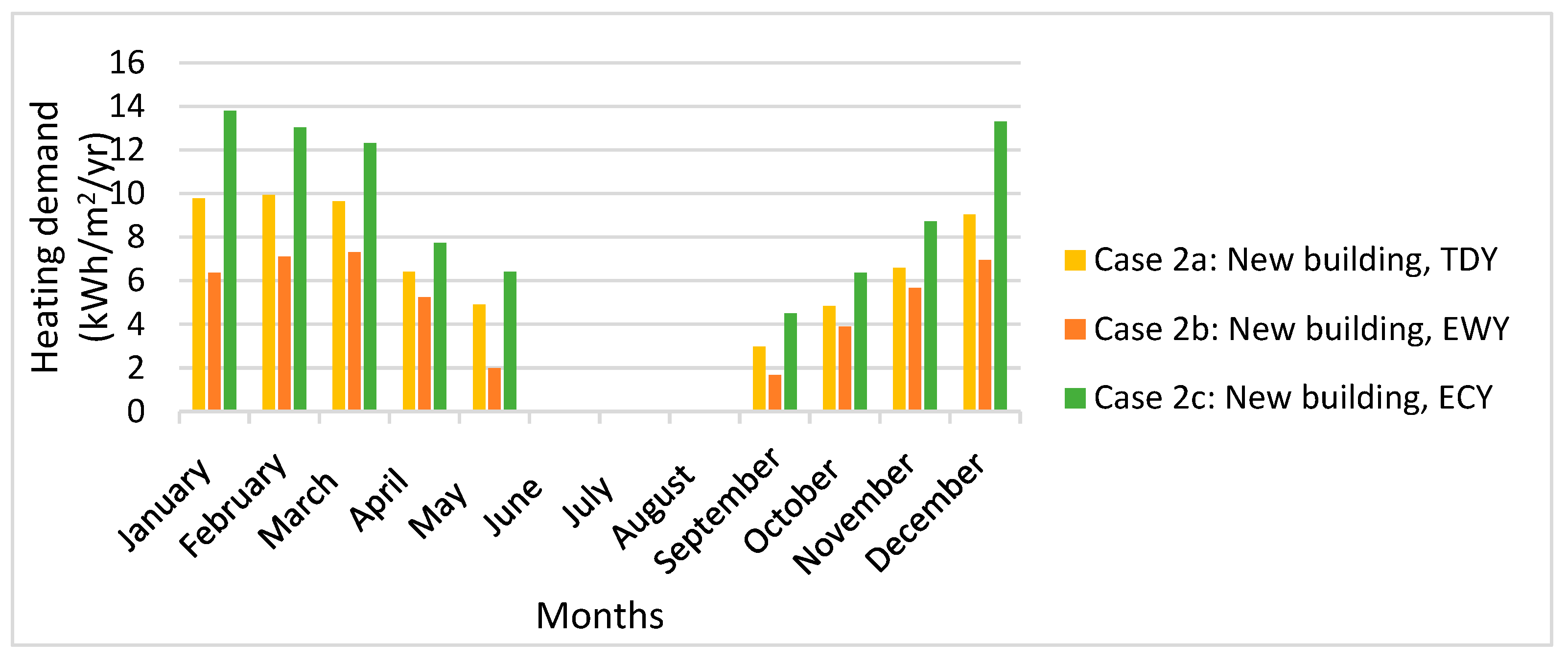
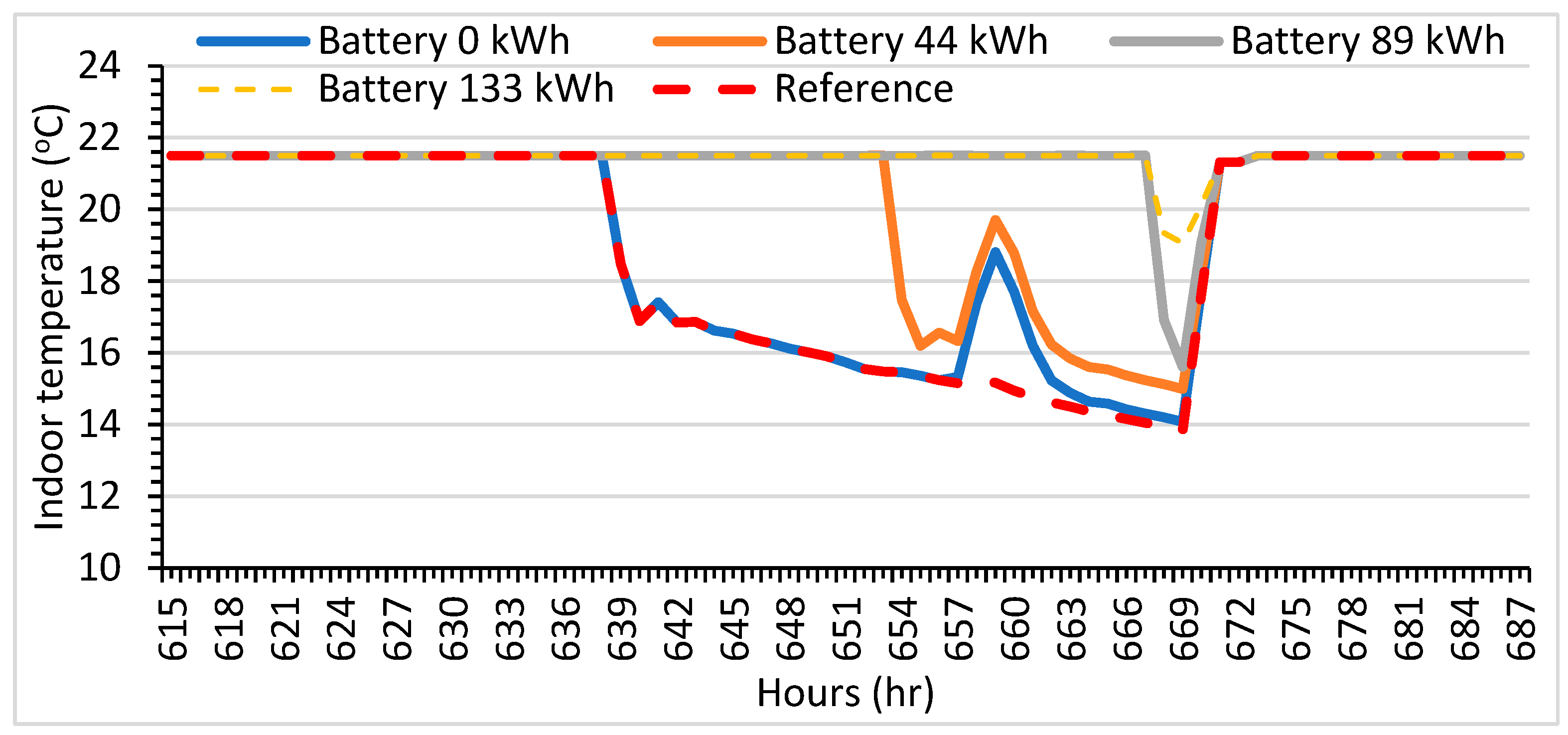

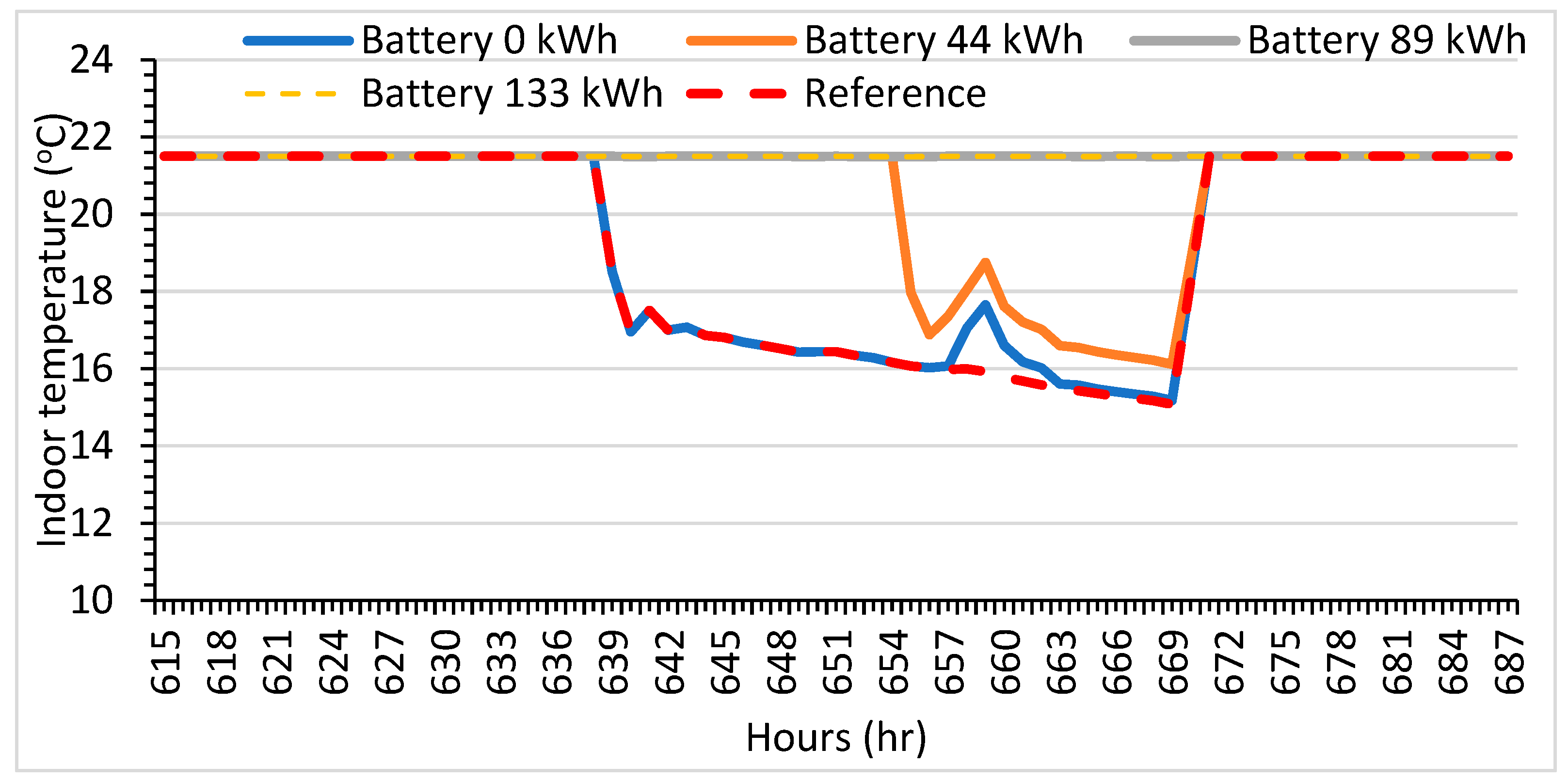
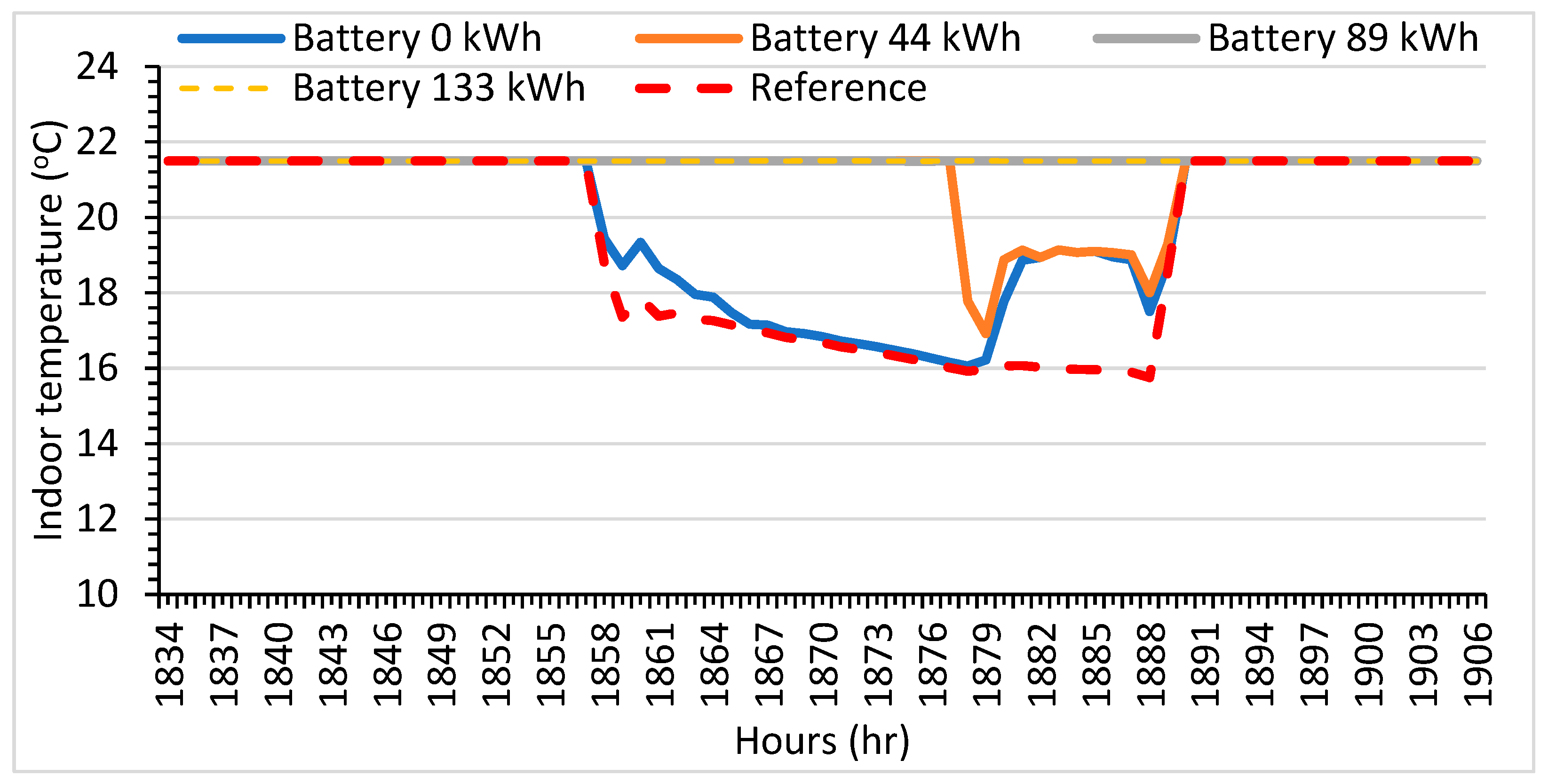
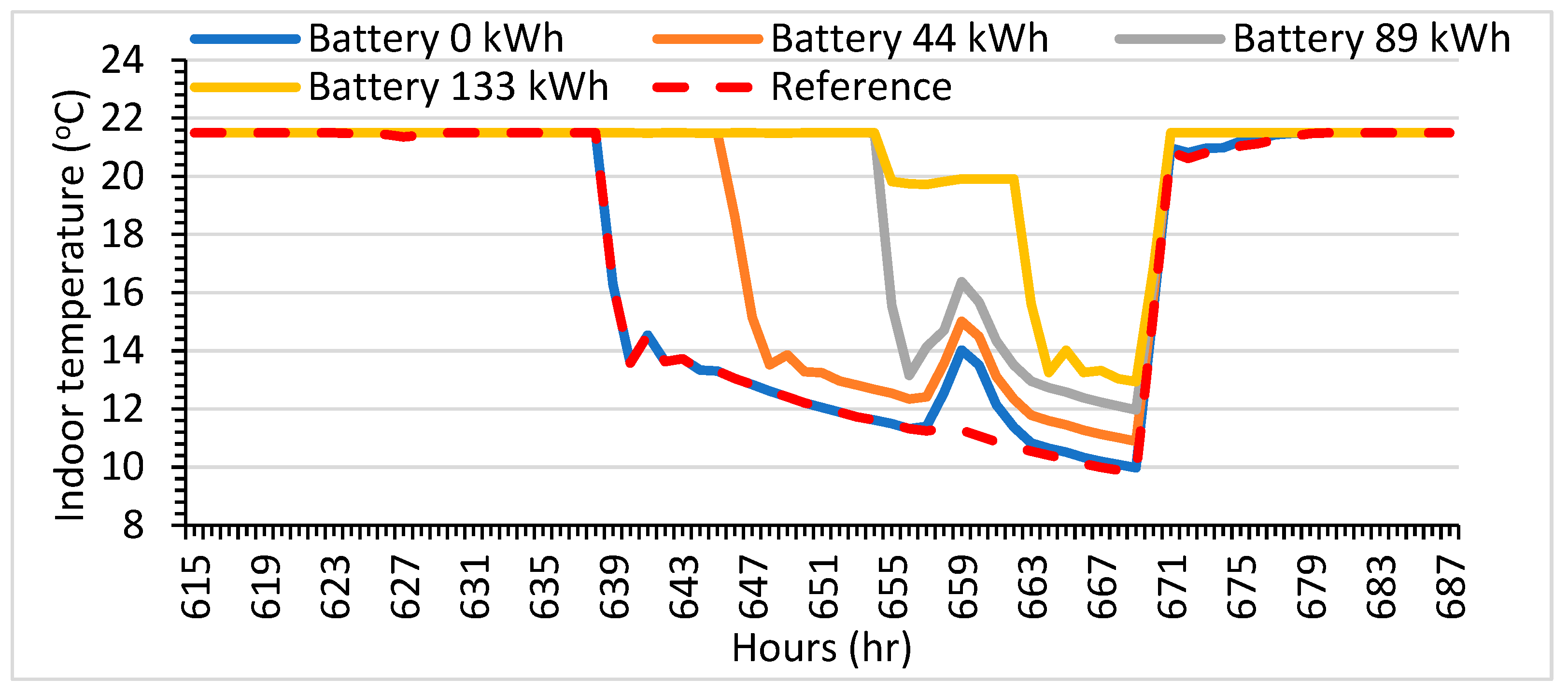

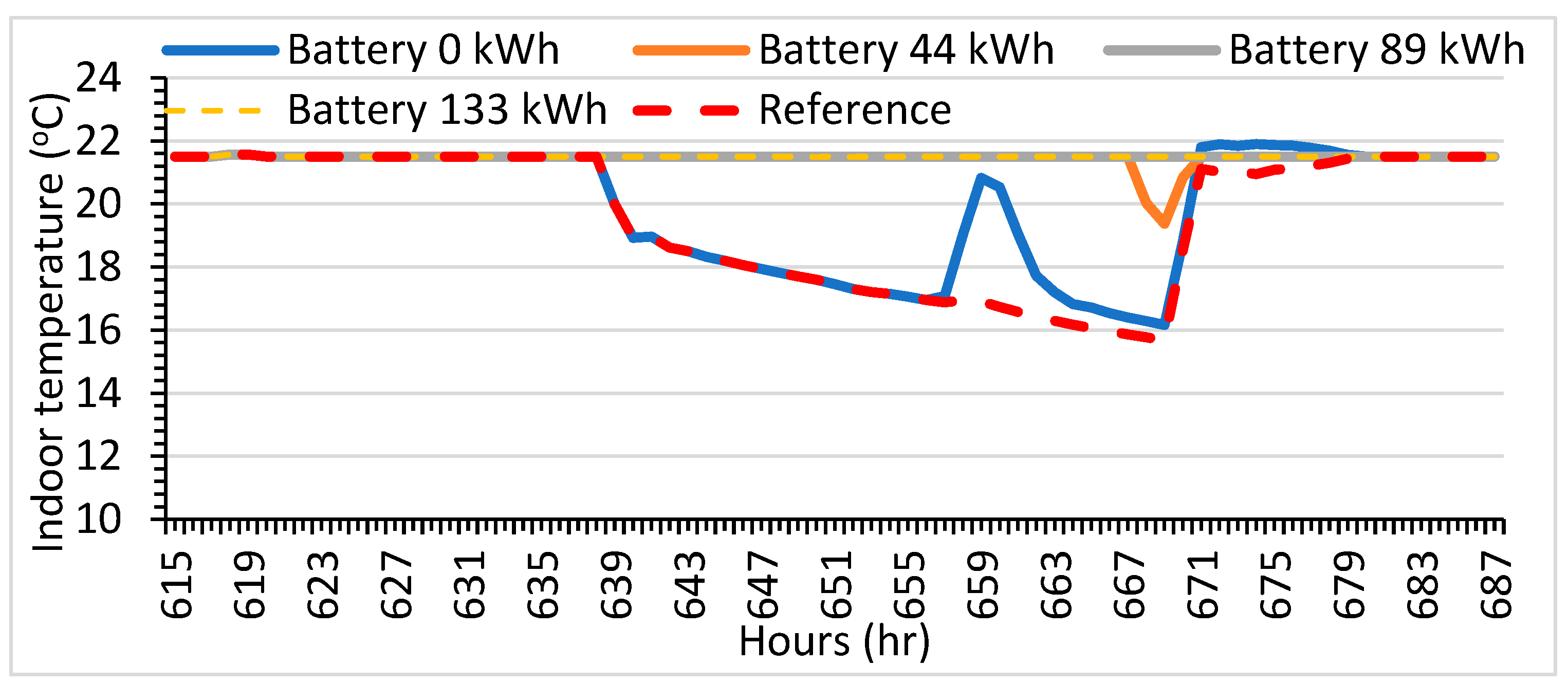
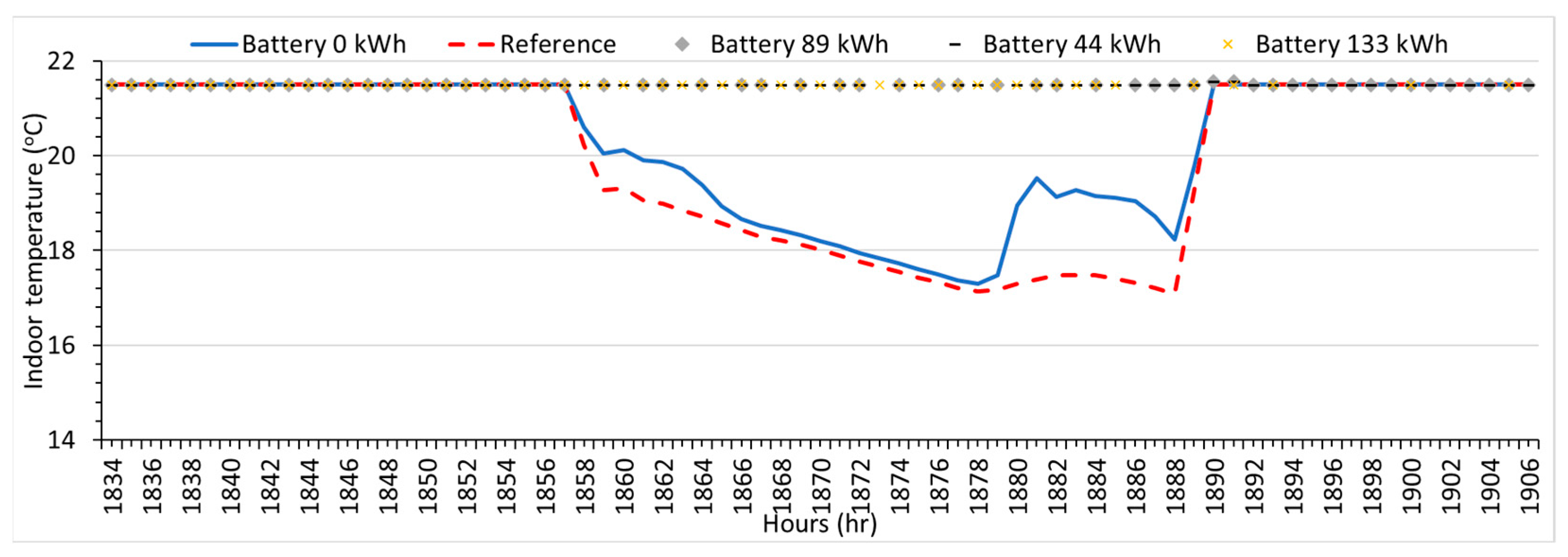

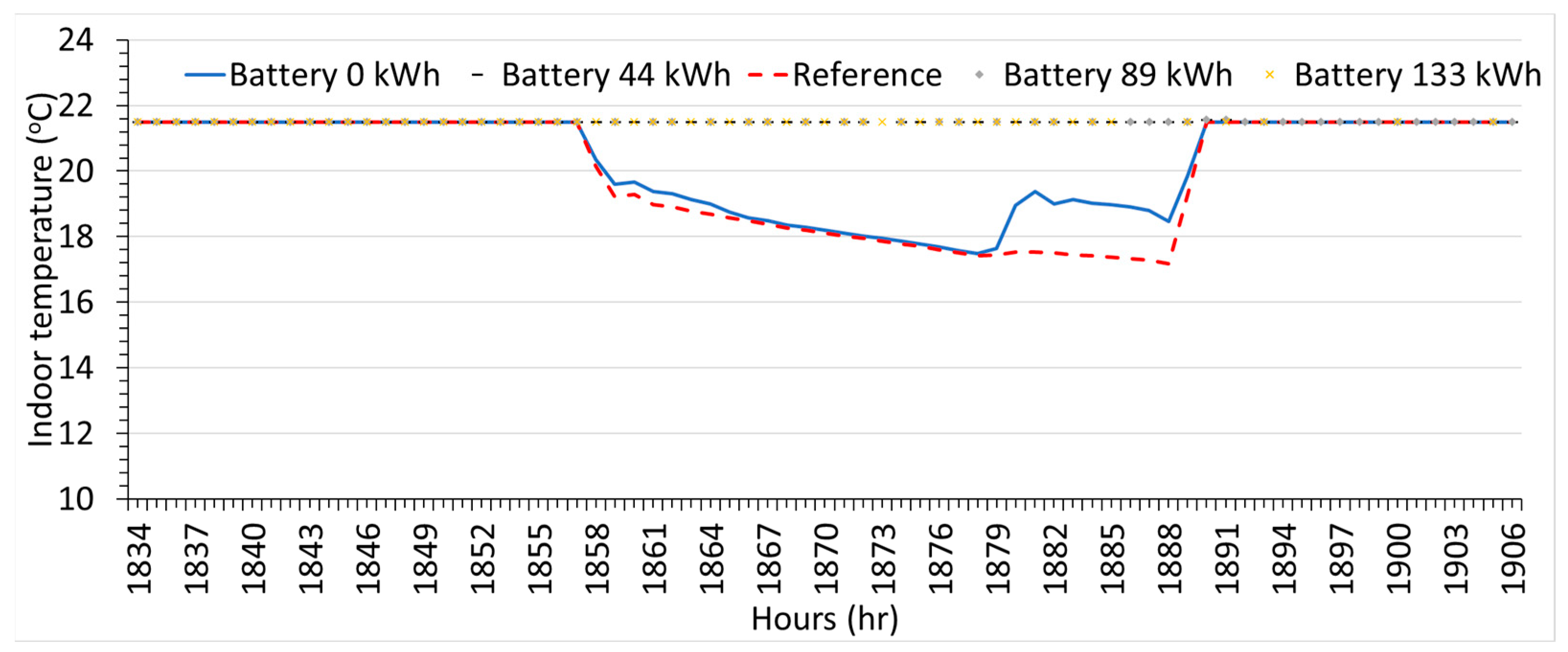
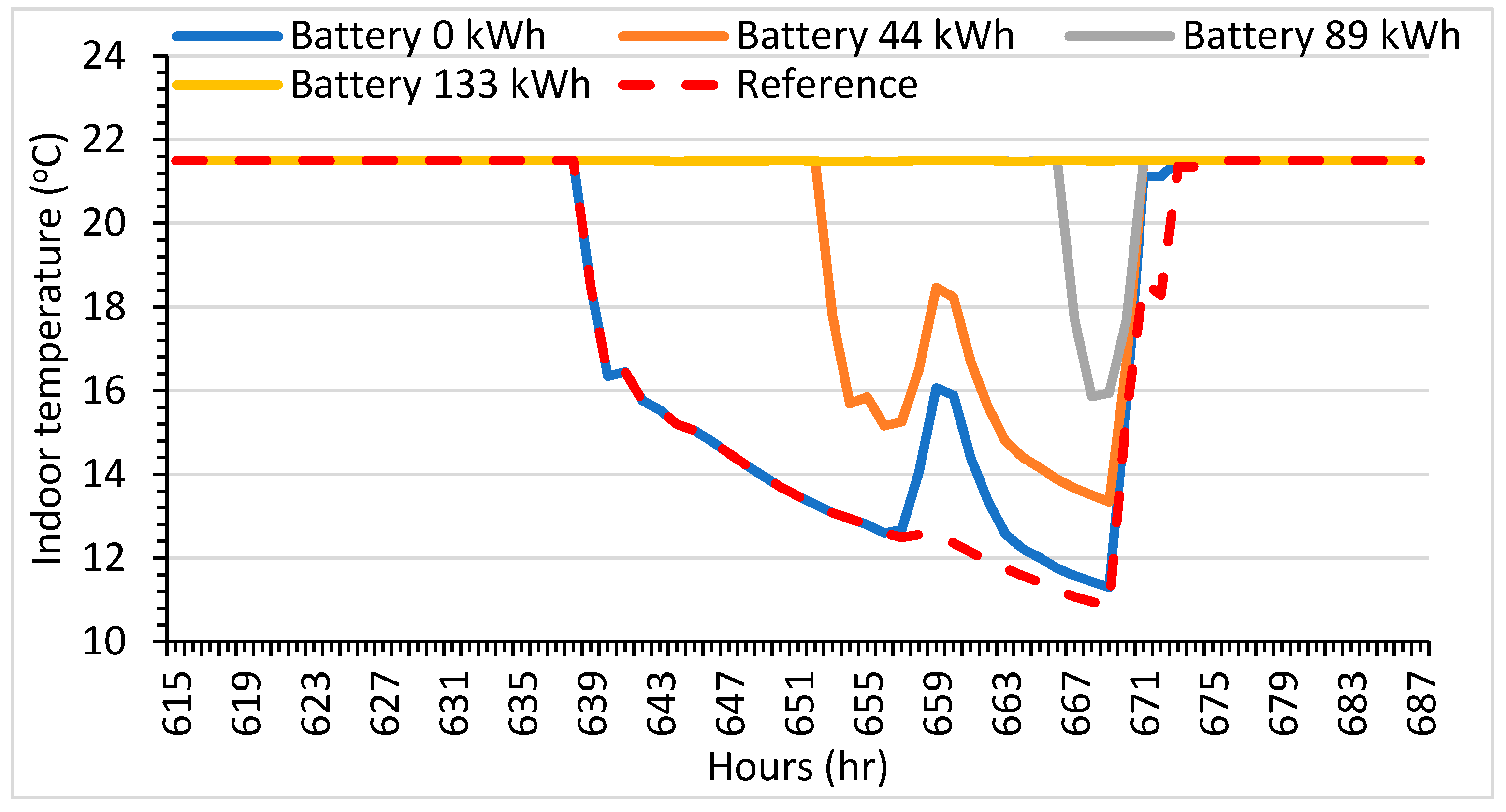

| Parameters of Building Envelope and Design | Value, Old Building (Properties (Density, Thickness)) | Value, New Building (Properties (Density, Thickness)) |
|---|---|---|
| Floor area | 100 m2 | 100 m2 |
| Walls (U value) | 0.5 W/m2 K, (Wood (500 kg/m3, 0.020 m), air (1.2 kg/m3, 0.022 m), wood fiber (250 kg/m3, 0.012 m), mineral wool (50 kg/m3, 0.063 m), polyamide film (1150 kg/m3, 0.001 m), gypsum (700 kg/m3, 0.013 m)) | 0.17 W/m2 K, (Lime mortar (1800 kg/m3, 0.01 m), concrete (2400 kg/m3, 0.1 m), mineral wool (50 kg/m3, 0.252 m), concrete (2400 kg/m3, 0.1 m), lime mortar (1800 kg/m3, 0.01 m)) |
| Floor (U value) | 0.38 W/m2 K, (Wood (500 kg/m3, 0.005 m), mineral wool (50 kg/m3, 0.099 m), polyamide film (1150 kg/m3, 0.001 m), air (1.2 kg/m3, 0.022 m), gypsum (700 kg/m3, 0.03 m)) | 0.16 W/m2 K, (Expanded Polystyrene insulation (20 kg/m3, 0.237 m), concrete (2400 kg/m3, 0.2 m), Light floor concrete (500 kg/m3, 0.02 m)) |
| Roof (U value) | 0.27 W/m2 K, (Gypsum (700 kg/m3, 0.013 m), air (1.2 kg/m3, 0.022 m), polyamide film (1150 kg/m3, 0.001 m), mineral wool (50 kg/m3, 0.149 m), air (1.2 kg/m3, 0.1 m), bitumen (1100 kg/m3, 0.010 m)) | 0.09 W/m2 K, (Lime mortar (1800 kg/m3, 0.01 m), concrete (2400 kg/m3, 0.150 m), mineral wool (50 kg/m3, 0.486 m), concrete cream (0.01 m, 1100 kg/m3)) |
| Windows (U value) | 2.5 W/m2 K | 1 W/m2 K |
| Ventilation | 0.55 1/h | 0.55 1/h |
| Tightness q50 | 6 m3/h m2 | 2 m3/h m2 |
| Component | Specification | Input Parameter Value |
|---|---|---|
| Photovoltaic (PV) | PV Area | Variable area for parametric analysis |
| Maximum peak power | 250 W | |
| Voltage (open) | 37.5 Volts | |
| Current (short) | 8.73 amperes | |
| TRNSYS module type | Type 194 | |
| Battery | Cell-rated energy capacity | 465 amperes |
| Battery capacity | Variable capacity for parametric analysis | |
| Charge voltage | 2.8 Volts | |
| Charge current | 85 amperes | |
| Charging efficiency | 0.9 | |
| Initial state of charge | 0 | |
| Depth of discharge | 0.1 | |
| TRNSYS module type | TRNSYS type 47b |
| Indicator | Equation |
|---|---|
| Robustness threshold duration (RT) | t1 − t0 |
| Collapse speed (CS) | (PST − PRT) + (PRT − Pmin)/t2 − t0 |
| Impact of failure (IoF) | (PST − PRT) + (PRT − Pmin) |
| Recovery speed (RS) | (PST − PRT) + (PRT − Pmin)/t3 − t2 |
| Building Type | Case Number | Climate Scenarios | Design Variables for Parametric Study | Tested Representative Seasons | Simulation Options | |
|---|---|---|---|---|---|---|
| Photovoltaic Panel’s Area Variable Values (m2) | Battery Capacity Variable Values (kWh) | |||||
| Old building (Case 1) | 1a | TDY | 0 | 0, 44, 89, 133 | Winter, spring | 8 |
| 1a | TDY | 50 | 0, 44, 89, 133 | Winter, spring | 8 | |
| 1a | TDY | 75 | 0, 44, 89, 133 | Winter, spring | 8 | |
| 1a | TDY | 100 | 0, 44, 89, 133 | Winter, spring | 8 | |
| 1b | EWY | 0 | 0, 44, 89, 133 | Winter, spring | 8 | |
| 1b | EWY | 50 | 0, 44, 89, 133 | Winter, spring | 8 | |
| 1b | EWY | 75 | 0, 44, 89, 133 | Winter, spring | 8 | |
| 1b | EWY | 100 | 0, 44, 89, 133 | Winter, spring | 8 | |
| 1c | ECY | 0 | 0, 44, 89, 133 | Winter, spring | 8 | |
| 1c | ECY | 50 | 0, 44, 89, 133 | Winter, spring | 8 | |
| 1c | ECY | 75 | 0, 44, 89, 133 | Winter, spring | 8 | |
| 1c | ECY | 100 | 0, 44, 89, 133 | Winter, spring | 8 | |
| New building (Case 2) | 2a | TDY | 0 | 0, 44, 89, 133 | Winter, spring | 8 |
| 2a | TDY | 50 | 0, 44, 89, 133 | Winter, spring | 8 | |
| 2a | TDY | 75 | 0, 44, 89, 133 | Winter, spring | 8 | |
| 2a | TDY | 100 | 0, 44, 89, 133 | Winter, spring | 8 | |
| 2b | EWY | 0 | 0, 44, 89, 133 | Winter, spring | 8 | |
| 2b | EWY | 50 | 0, 44, 89, 133 | Winter, spring | 8 | |
| 2b | EWY | 75 | 0, 44, 89, 133 | Winter, spring | 8 | |
| 2b | EWY | 100 | 0, 44, 89, 133 | Winter, spring | 8 | |
| 2c | ECY | 0 | 0, 44, 89, 133 | Winter, spring | 8 | |
| 2c | ECY | 50 | 0, 44, 89, 133 | Winter, spring | 8 | |
| 2c | ECY | 75 | 0, 44, 89, 133 | Winter, spring | 8 | |
| 2c | ECY | 100 | 0, 44, 89, 133 | Winter, spring | 8 | |
| Cost Component | PV | Battery | Reference |
|---|---|---|---|
| Investment cost | 124 €/m2 | 600 €/kWh | [67,68] |
| Operational and maintenance cost | 1.5% of the investment cost | 1.5% of the investment cost | [67,68] |
| Duration | 25 years | 12.5 years | [67,68] |
| Replacement cost | Included in the maintenance cost | 200 €/kWh | [67,68] |
| Climate Scenarios, Corresponding Heating Demand | |||
| Heating Demand Parameters, Old Building | TDY (1a) | EWY (1b) | ECY (1c) |
| Old building heating demand (kWh/m2/yr) | 158.33 | 124.42 | 199.47 |
| Difference in the heating demand from TDY (kWh/m2/yr) | - | −33.91 | 41.14 |
| Relative difference in the demand from TDY (%) | - | 21.5% | 26% |
| Climate Scenarios, Corresponding Heating Demand | |||
| Heating Demand Parameters, New Building | TDY (2a) | EWY (2b) | ECY (2c) |
| New building heating demand (kWh/m2/yr) | 64.06 | 46.12 | 86.08 |
| Difference in the demand from TDY (kWh/m2/yr) | - | −17.94 | 22.02 |
| Relative difference in the demand from TDY (%) | - | 28% | 34.3% |
| PV Area, m2 | 0 | 50 | 75 | 100 | ||||||||||||
|---|---|---|---|---|---|---|---|---|---|---|---|---|---|---|---|---|
| Battery Capacity, kWh | 0 | 44 | 89 | 133 | 0 | 44 | 89 | 133 | 0 | 44 | 89 | 133 | 0 | 44 | 89 | 133 |
| Case 1a (TDY) winters: Degree of disruption (DoD) | 0.357 | 0.357 | 0.357 | 0.357 | 0.351 | 0.308 | 0.289 | 0.289 | 0.348 | 0.305 | 0.274 | 0.114 | 0.334 | 0.293 | 0.274 | 0.114 |
| Case 2a (TDY) winters: Degree of disruption (DoD) | 0.271 | 0.271 | 0.271 | 0.271 | 0.257 | 0.099 | 0.000 | 0.000 | 0.251 | 0.099 | 0.000 | 0.000 | 0.248 | 0.099 | 0.000 | 0.000 |
| Old Building | New Building | |||||||||||
|---|---|---|---|---|---|---|---|---|---|---|---|---|
| PV Area, m2 | 75 | 50 | 50 | 50 | 100 | 50 | 50 | 50 | 50 | 50 | 50 | 50 |
| Battery Capacity, kWh | 133 | 89 | 89 | 44 | 133 | 133 | 44 | 44 | 44 | 44 | 89 | 44 |
| Case | 1a TDY, Winter | 1a TDY, Spring | 1b EWY, Winter | 1b EWY, Spring | 1c ECY, Winter | 1c ECY, Spring | 2a TDY, Winter | 2a TDY, Spring | 2b EWY, Winter | 2b EWY, Spring | 2c ECY, Winter | 2c ECY, Spring |
| Degree of disruption (DoD) | 0.114 | 0 | 0.172 | 0.153 | 0.398 | 0.141 | 0.099 | 0 | 0 | 0 | 0.254 | 0 |
| PV cost (€) | 9851 | 6838 | 6838 | 6838 | 12,864 | 6838 | 6838 | 6838 | 6838 | 6838 | 6838 | 6838 |
| Battery cost (€) | 119,027 | 79,649 | 79,649 | 39,377 | 119,027 | 119,027 | 39,377 | 39,377 | 39,377 | 39,377 | 79,649 | 39,377 |
Disclaimer/Publisher’s Note: The statements, opinions and data contained in all publications are solely those of the individual author(s) and contributor(s) and not of MDPI and/or the editor(s). MDPI and/or the editor(s) disclaim responsibility for any injury to people or property resulting from any ideas, methods, instructions or products referred to in the content. |
© 2024 by the authors. Licensee MDPI, Basel, Switzerland. This article is an open access article distributed under the terms and conditions of the Creative Commons Attribution (CC BY) license (https://creativecommons.org/licenses/by/4.0/).
Share and Cite
Rehman, H.u.; Nik, V.M.; Ramesh, R.; Ala-Juusela, M. Quantifying and Rating the Energy Resilience Performance of Buildings Integrated with Renewables in the Nordics under Typical and Extreme Climatic Conditions. Buildings 2024, 14, 2821. https://doi.org/10.3390/buildings14092821
Rehman Hu, Nik VM, Ramesh R, Ala-Juusela M. Quantifying and Rating the Energy Resilience Performance of Buildings Integrated with Renewables in the Nordics under Typical and Extreme Climatic Conditions. Buildings. 2024; 14(9):2821. https://doi.org/10.3390/buildings14092821
Chicago/Turabian StyleRehman, Hassam ur, Vahid M. Nik, Rakesh Ramesh, and Mia Ala-Juusela. 2024. "Quantifying and Rating the Energy Resilience Performance of Buildings Integrated with Renewables in the Nordics under Typical and Extreme Climatic Conditions" Buildings 14, no. 9: 2821. https://doi.org/10.3390/buildings14092821








